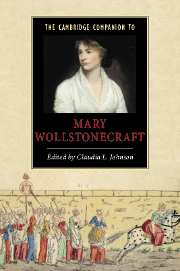Book contents
- Frontmatter
- 1 Introduction
- 2 Mary Wollstonecraft's letters
- 3 Mary Wollstonecraft on education
- 4 Mary Wollstonecraft's Vindications and their political tradition
- 5 Mary Wollstonecraft's French Revolution
- 6 Mary Wollstonecraft's literary reviews
- 7 The religious foundations of Mary Wollstonecraft's feminism
- 8 Mary Wollstonecraft and the literature of advice and instruction
- 9 Mary Wollstonecraft's A Vindication of the Rights of Woman and the women writers of her day
- 10 Mary Wollstonecraft and the poets
- 11 Mary Wollstonecraft's novels
- 12 Letters Written During a Short Residence in Sweden, Norway, and Denmark: traveling with Mary Wollstonecraft
- 13 Mary Wollstonecraft and the sexuality of genius
- 14 Mary Wollstonecraft's reception and legacies
- Select bibliography
- Index
14 - Mary Wollstonecraft's reception and legacies
Published online by Cambridge University Press: 28 May 2006
- Frontmatter
- 1 Introduction
- 2 Mary Wollstonecraft's letters
- 3 Mary Wollstonecraft on education
- 4 Mary Wollstonecraft's Vindications and their political tradition
- 5 Mary Wollstonecraft's French Revolution
- 6 Mary Wollstonecraft's literary reviews
- 7 The religious foundations of Mary Wollstonecraft's feminism
- 8 Mary Wollstonecraft and the literature of advice and instruction
- 9 Mary Wollstonecraft's A Vindication of the Rights of Woman and the women writers of her day
- 10 Mary Wollstonecraft and the poets
- 11 Mary Wollstonecraft's novels
- 12 Letters Written During a Short Residence in Sweden, Norway, and Denmark: traveling with Mary Wollstonecraft
- 13 Mary Wollstonecraft and the sexuality of genius
- 14 Mary Wollstonecraft's reception and legacies
- Select bibliography
- Index
Summary
Virginia Woolf, in 1929, described Mary Wollstonecraft's remarkable “form of immortality” through the memorable conceit that “she is alive and active, she argues and experiments, we hear her voice and trace her influence even now among the living.” A strong sense of unfinished business hovers about Wollstonecraft's legacy – the effects of a life cut short and a political agenda not yet met, but also of something less straightforward, emanating from the combined – but disjunctive – force of her life and work as well as yoked with the seductive fiction that revolution and romance have some natural and dangerously volatile affinity. For “even now,” at the beginning of the twenty-first century, Woolf's perception of an embodied, social and affective presence – “alive . . . among the living” – captures what has proved most enduring but also most troubling about Wollstonecraft's reception, the aura of unreconciled emotion that hovers around her shifting reputation. Wollstonecraft remains an ambiguous symbol both of feminism and of femininity, her significance disputed most strongly by the diverse western feminisms of the last quarter of the twentieth century which have made her and her feminist peers living and legible in her own time and in theirs. Their disagreements have been productive as well as divisive; it is to the credit of Wollstonecraft's interpreters that she remains a restive presence, who cannot be easily framed or honorably laid to rest as the distinguished foremother of modern feminism.
- Type
- Chapter
- Information
- The Cambridge Companion to Mary Wollstonecraft , pp. 246 - 270Publisher: Cambridge University PressPrint publication year: 2002
- 10
- Cited by



